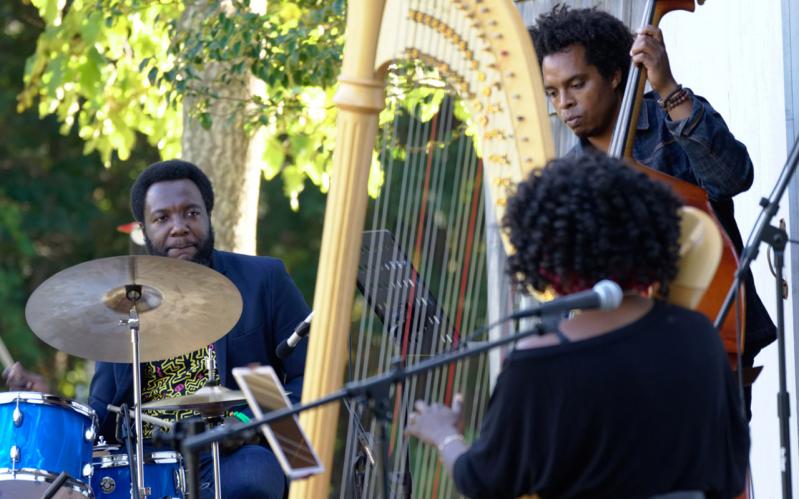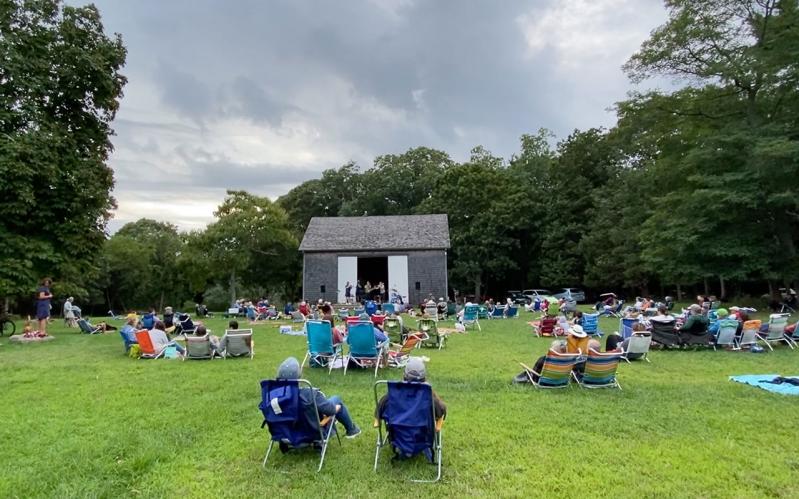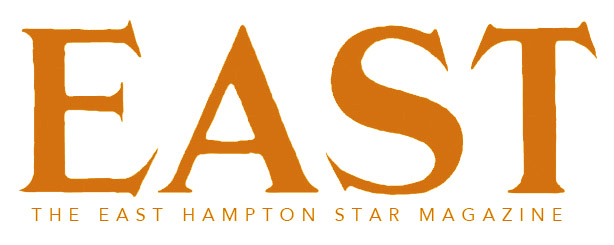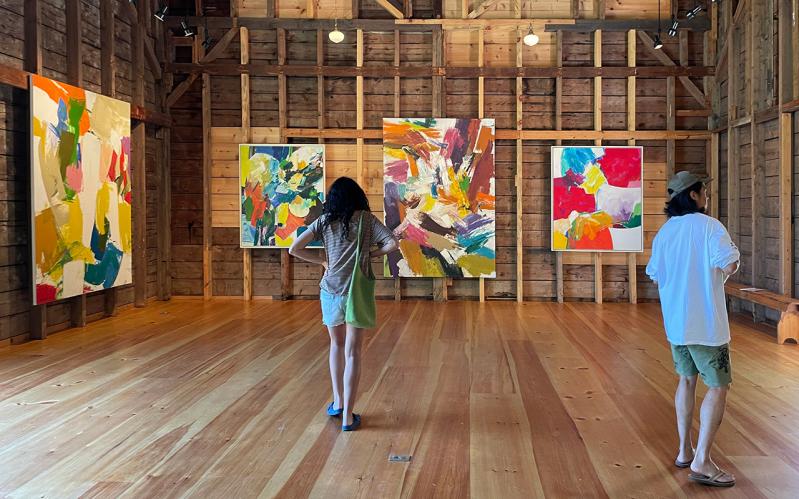On a warm summer afternoon, people walk in twos and threes carrying lawn chairs and picnics along an oak-shaded side road in Springs. A couple arrives by bicycle, with a small dog in a basket.
Their destination is a hidden jewel of a public space, the Arts Center at Duck Creek, a tiny institution that came to exist almost by accident — and that is keeping pace with the cultural big guns of the South Fork.
It is a little difficult to know where to begin — the centuries-long story of the site or the neighbors and art lovers who have banded up to bring it to life. Now in its fifth year, Duck Creek offers a full schedule of exhibitions by artists from near and far and a jazz series of free performances, the ones that draw the audiences in their lawn chairs.
The history of the property is as varied as any here. After the dispossession of the native Montaukett people, a member of the Gardiner family ended up with the land, selling it in 1795 to John Edwards, whose descendants farmed it until 1920. Their wheat was said to be the finest for bread-baking around. They also raised horses and oxen on its 130 acres.
Nothing could be sold there, so the exhibitions were selected not for what might be hot on the art market but because they were simply interesting.
Some of the Gardiner clan bought it back in 1920. By then, what had originally extended along thousands of feet of Three Mile Harbor waterfront was being broken into many smaller parcels. Weakened by neglect, the roof blew off the house in the Hurricane of 1938. Ten years after that, according to the generally accepted version of events, the painter Lee Krasner took John Little, a friend of hers, to see it. Little, a painter of the New York School who had spent time as the guest of Krasner and her husband, Jackson Pollock, at their house in Springs, was sold.
After taking possession of the property, Little spent months removing crumbling plaster and stabilizing the house. Little’s place at Duck Creek was something of a salon and attraction for painters and others from the city, whom he hoped would fall in love with the area as he had. He died in 1984; his daughters sold the property to the fashion designer Helmut Lang.
The Town of East Hampton struck a deal in 2005 to buy the property with money from its 2-percent preservation tax. But it took ownership without a definite plan for the nearly seven acres. It fell to people who lived nearby to push for its opening to the public. Few could have anticipated what it would become, and it took time.
Duck Creek Farm sat mostly untouched. Then, in the summer of 2013, after a year and a half of work shoring up the buildings, the restored barn debuted as an art space with an immersive exhibit by the fabric artist Sydney Albertini.
The following summer, the East Hampton Town fire marshal’s office shut down as unsafe an installation by the light artist Christine Sciulli that filled the space with gossamer fabric onto which projections played and danced in the otherwise pitch-black space.

The shows give new life to the idea for a nonprofit community arts center. Early on, the group called themselves the John Little Society, but as plans settled, it became the Arts Center at Duck Creek, led by a small group of Springs residents, including Ira Barocas, Zachary Cohen, Pamela Bicket, and Loring Bolger. Jess Frost, a peripatetic curator and largely disillusioned art archivist who lived nearby, joined, too. (She had been very close to chucking it all and moving to Oregon to become a park ranger.)
Frost said that the town’s ownership served as a bulwark against the corporatization pressure that other many arts institutions have to confront. Nothing could be sold there, so the exhibitions were selected not for what might be hot on the art market but because they were simply interesting. This has meant tapping younger visual artists and musicians from out of the area and locals whose work was not widely known. “In order to get people to come to a venue, you have to stretch a little bit.”
The Willem de Kooning Foundation and HiLo Foundation are major donors but do not lean on them to do anything, Frost said.
“We present shows without pretense. We are extremely welcoming when people come in. We’re not burying ourselves in art-speak.”

Paintings that Little had made in 1948 showed in the barn last summer. At some point during the exhibition, Frost had a revelation that they were just one group in a long line of people who had tended the property. “We are stewarding this place for the moment,” she said.
“We are growing organically. The things we are doing are really coming from the community,” Frost said.
As the Arts Center at Duck Creek, or A.C.D.C. — maybe in a sly nod to fans of the never-say-die Australian rock band — it created programing that dipped into the present-day East End artist community and also its history as an art colony.
Visual art is A.C.D.C.’s main pillar, focusing significantly on the work of painters and sculptors from the East End. (These include Hiroyuki Hamada, who both showed paintings and curated an exhibit of new-breed Hudson Valley artists. Julian Schnabel curated an under-the-radar show of paintings by Wayne Magrin, an Australian artist, last summer.) But it is essentially an outdoor venue — and that setting lends itself to gatherings on the grass for music and performances of other kinds.

The jazz concerts organized by Peter Watrous were a rare diversion during the height of the Covid-19 pandemic. A group of about 20 members of the Maidstone Club “adopted” the jazz concerts, Frost said. A.C.D.C. began booking younger and experimental musicians, more comfortable with travel and being in a group setting than standards-playing white-beards might be.
That fall, “there were a trio of kids in their 20s, a young Black woman, an amazing Korean drummer,” Frost said. “We thought, ‘Let’s see if this will bring in a different crowd.’ ” For her and the board, the mission was to expand the diversity of the audience, not make it bigger, she said.
Long term, the hope is to restore the Edwards house, and maybe offer off-season programs. For Frost and everyone involved, there seems a higher calling; “If I am going to stay in this community, I am going to have to build what I want from it,‘’ she said, a prescription, perhaps, for what’s ailing the East End as a whole.
COMING UP THIS SUMMER:
On July 30, the filmmaker Bill Morrison (The Village Detective: a song cycle and Dawson City: Frozen Time) and the composer and guitarist Bill Frisell are scheduled to play a double bill, for which reservations are required.
Miriam Elhajli, a folk artist and musicologist with Venezuelan, Moroccan, and North American heritage, will play there on August 6. Bird’s Eye, with the saxophonist and composer David Leon and Doyeon Kim on gayageum and Lesley Mok on drumset and percussion, will play “guided improvisation” inspired by Cuban and Korean folk music forms on August 13.
A show of the work of the late sculptor William King is on view on the grounds and in the barn until July 10, with work by Ross Watts, a conceptual artist, in a new smaller gallery space. Eric Brown’s “textile” paintings will be on view beginning on July 23, along with a dual exhibition of work by Hannah Beerman and Rafael Vega, both New York City–based painters, curated by Barry Schwabsky, the art critic for The Nation magazine and Artforum contributor, who lives in East Hampton part time; there will be a reception on the evening of the opening, at 5.
From August until Columbus Day, Wendy Klemperer’s welded steel animal forms will be on the grounds. A show of sculpture by Sally Richardson, who grew up in a coastal village in East Anglica, England but now lives in Montauk, will open Sept. 10.


